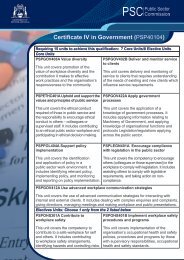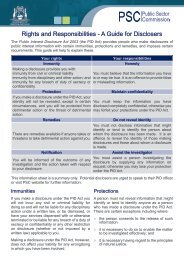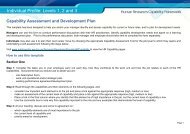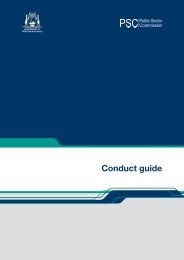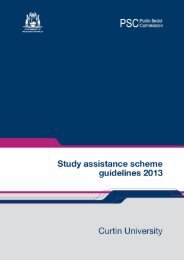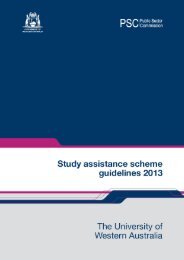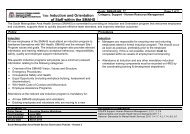Archived document - Public Sector Commission - The Western ...
Archived document - Public Sector Commission - The Western ...
Archived document - Public Sector Commission - The Western ...
Create successful ePaper yourself
Turn your PDF publications into a flip-book with our unique Google optimized e-Paper software.
e-Government Strategy for the <strong>Western</strong> Australian <strong>Public</strong> <strong>Sector</strong><br />
Understanding e-Government<br />
14<br />
Phase Two – Interaction<br />
This phase represents the primary development of citizens interacting<br />
with government via online facilities. Whilst citizens may still access<br />
information and services through traditional channels, such as by phone<br />
or in person, phase two represents an environment in which citizens can<br />
order and execute services online. <strong>The</strong>y may also manipulate information<br />
databases, use search mechanisms and linkages to other related sites.<br />
This phase also introduces the beginning of common entry points that aim<br />
to remove the need for citizens to understand government structures to<br />
access government services, and deliver the first high-volume transactions<br />
in limited instances.<br />
Phase Three – Transaction<br />
In this phase, citizens are able to equally access government services via<br />
many channels (e.g. online, wireless or PDA technologies) of delivery and<br />
agencies have begun to reform their business processes such that<br />
services can be delivered via a variety of channels as a matter of course.<br />
This will increase the convenience factor for citizens and businesses using<br />
government services.<br />
<strong>The</strong>re is a greater removal of the need for citizens to understand the<br />
structures of government as increased shared services and collaboration<br />
between agencies has resulted in greater information sharing and service<br />
initiation. Privacy and security concerns have been effectively managed<br />
such that civic and industrial trust in e-government services is high.<br />
Personalisation of service delivery is commonplace, and the value<br />
proposition of services has been maximised such that take-up of e-<br />
government initiatives is consistently high. Communication between<br />
citizens/business and government is now more akin to two-way<br />
conversation and the beginning of proactive service delivery is being seen.




